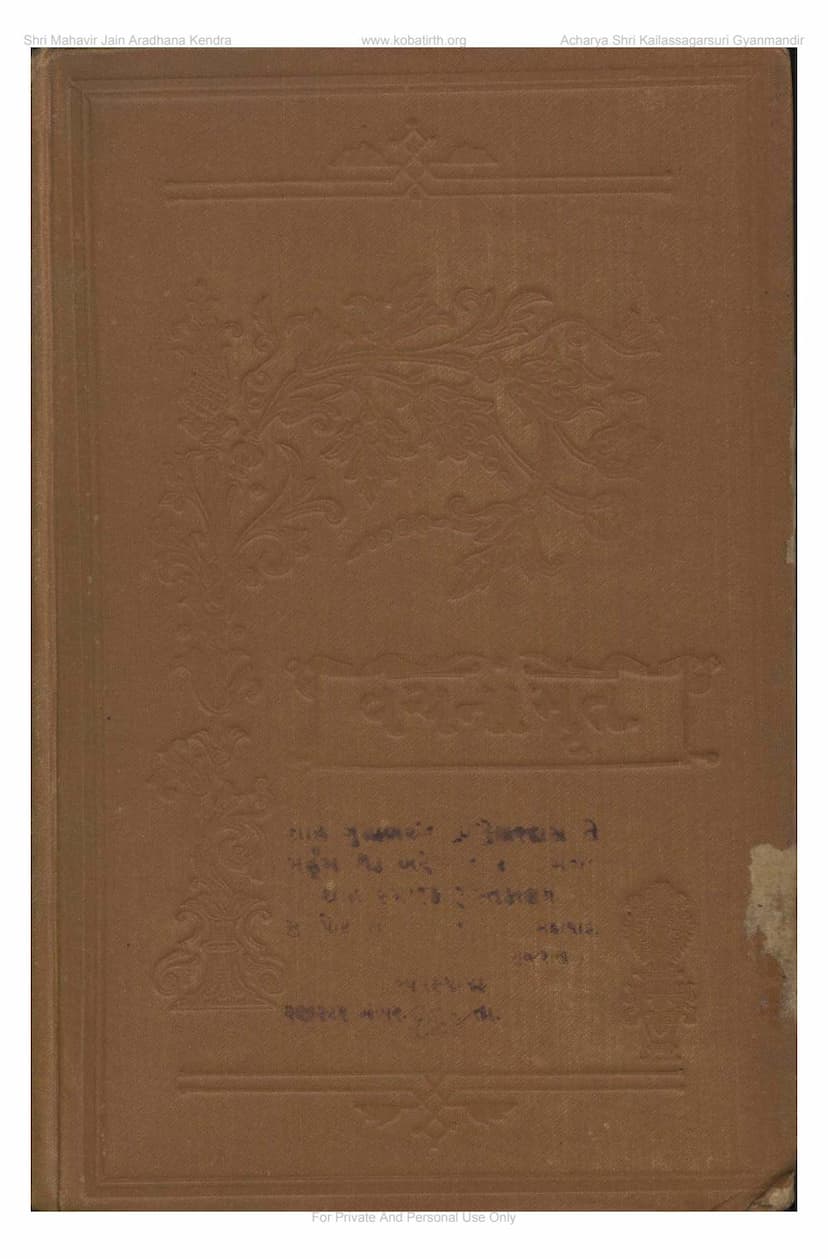Vachanamrut
Added to library: September 2, 2025

Summary
Here's a comprehensive summary of the Jain text "Vachanamrut" by Buddhisagar, based on the provided pages:
Book Title: Vachanamrut Author: Buddhisagar Publisher: Adhyatma Gyan Prasarak Mandal Catalog Link: https://jainqq.org/explore/008680/1
Overall Summary:
"Vachanamrut" (Nectar of Words) is a Jain text compiled and published by Adhyatma Gyan Prasarak Mandal, authored by Muni Shrimad Buddhisagarji. It is presented as the 22nd volume in the Shrimad Buddhisagarji Granthamala series. The book is dedicated to the memory of Seth Nagenidas Kapurchand Zaveri, with assistance from his son.
The "Vachanamrut" is a collection of the profound spiritual sayings and writings of Acharya Buddhisagarji, delivered on various occasions and in different locations. The publisher highlights that these sayings are not only intellectually stimulating but also practically useful and mentally engaging for the readers. The preface also mentions that three other highly beneficial books, each with three editions, are included: "Gunanurag," "Shravak Dharma Swaroop Part 1," and "Part 2."
The core of the "Vachanamrut" focuses on spiritual guidance, emphasizing detachment from worldly possessions and attachments. It strongly advocates for the understanding and realization of the soul's true nature, which is described as eternal, pure, and blissful. The text repeatedly stresses the impermanence of the material world, including the body, relationships, and wealth, urging readers to focus on the self (Atman) as the only eternal reality.
Key Themes and Teachings:
-
The Nature of the Soul (Atman): The text elaborates on the true nature of the soul as distinct from the body and material possessions. It is described as eternal, formless, conscious, and inherently blissful, though currently obscured by karmic coverings. The ultimate goal is to realize this true nature, which is akin to the soul's inherent state of liberation (Moksha).
-
Detachment and Renunciation (Vairagya): A central theme is the necessity of detachment from worldly pleasures, relationships, and possessions. These are repeatedly described as impermanent and ultimately leading to suffering. The book encourages a path of renunciation (Vairagya) to break free from the cycle of birth and death.
-
Understanding Karma and Liberation (Moksha): The text explains that the soul's suffering and transmigration through various life forms are due to the accumulation of karma. It emphasizes that by understanding the self, renouncing attachments, and practicing virtues, one can shed karmic bonds and achieve liberation (Moksha). The path involves right faith (Samyak Darshan), right knowledge (Samyak Gyan), and right conduct (Samyak Charitra).
-
The Importance of Righteous Conduct and Virtues: The book lists and expounds on various virtues that are essential for spiritual progress. These include honesty, non-violence (Ahimsa), truthfulness, non-stealing, celibacy, detachment, forgiveness, patience, contentment, and equanimity.
-
Critique of Worldly Attachments: The text often uses vivid language to illustrate the futility of worldly pursuits. It compares worldly attachments to fleeting illusions, emphasizing that attachment to external objects leads to misery.
-
The Role of the Guru: The importance of a spiritual guide (Guru) is highlighted as crucial for understanding the true nature of the soul and the path to liberation. The Guru's teachings and guidance are considered essential for navigating spiritual practice.
-
The Importance of Self-Reflection and Righteous Action: The text encourages constant self-reflection (Atma-vichar) and right action aligned with Jain principles. It emphasizes introspection to identify and rectify one's own faults rather than criticizing others.
-
The Fourfold Support (Naya): The text implicitly or explicitly refers to the Jain philosophical concept of multiple perspectives (Naya) for understanding reality, suggesting that truth can be viewed from different angles.
-
Specific Jain Practices: The book touches upon various Jain practices and concepts such as the importance of the Paryushan festival, the principles of the Shravak Dharma (lay follower's duties), the significance of rituals like Angi Puja, and the philosophical underpinnings of Jainism like Anekantavada (the doctrine of manifold aspects).
-
The Life of Seth Nagenidas Kapurchand Zaveri: A significant portion of the initial pages is dedicated to the biography of Seth Nagenidas Kapurchand Zaveri, a prominent and charitable Jain layman. This section details his birth, lifespan, business acumen, philanthropic activities, and devotion to his spiritual preceptor. His extensive charitable donations for temples, cow protection, religious education, and community welfare are enumerated, highlighting his exemplary life as a true follower of Jain principles.
Structure and Content:
The book is structured to guide the reader from understanding the soul's true nature to practicing the path of righteousness. It moves from the fundamental principles of Jainism to practical aspects of daily life for a Jain follower. The text uses accessible language, often employing parables and analogies to convey complex spiritual concepts. The inclusion of the life of Seth Nagenidas Kapurchand Zaveri serves as a practical example of how Jain principles can be lived out in worldly life.
Overall Impact:
"Vachanamrut" aims to be a spiritual and practical guide for Jain followers, encouraging them to strive for self-realization and liberation by detaching from the material world and cultivating inner virtues. It serves as a source of inspiration and a reminder of the eternal truths of Jain philosophy.